Treating diabetic retinopathy
Treating diabetic retinopathy is a critical aspect of preserving vision and maintaining the overall quality of life for patients suffering from diabetes. Diabetic retinopathy is a common complication of diabetes that affects the blood vessels in the retina – the light-sensitive tissue at the back of the eye.
According to the National Eye Institute, approximately 7.7 million Americans are estimated to have diabetic retinopathy, and that number is expected to rise to 14.6 million by 2050. Early detection and intervention can significantly reduce the risk of vision loss, making it vital for patients with diabetes to undergo regular eye exams and follow a personalized treatment plan.
The Role of The Optometrist and Ophthalmologist in the Management of Diabetic Retinopathy
The role of the optometrist and ophthalmologist in the management of diabetic retinopathy is distinct yet synergistic. Optometrists, as primary eye care professionals, are often the first line of defense in detecting diabetic retinopathy. They conduct comprehensive eye examinations and utilize advanced diagnostic technologies to identify early signs of the condition. Once detected, optometrists play a crucial role in patient education, explaining the implications of the disease, and offering advice on lifestyle adjustments to mitigate its progression. Ophthalmologists, on the other hand, are medical doctors specialized in eye and vision care who have completed additional training to handle more complex cases. In the context of diabetic retinopathy, they are often involved when the condition requires more invasive treatments such as laser surgery, vitrectomy, or injection of medications into the eye. Their expertise is vital in managing advanced stages of the disease and mitigating complications. Together, these professionals form a united front in the comprehensive management of diabetic retinopathy, combining preventative and therapeutic measures for optimal patient care.
Treatment Options for Diabetic Retinopathy
There are several treatment options available for diabetic retinopathy, which can vary depending on the stage of the condition and the specific needs of each patient. These treatments are designed to slow down or halt the progression of retinopathy, minimize the risk of vision loss, and, in some cases, improve visual acuity. Key treatment options for diabetic retinopathy include:
Blood sugar management
The cornerstone of any treatment plan for diabetic retinopathy is effectively managing blood sugar levels. Patients with well-controlled diabetes are less likely to experience vision-threatening complications, so it's essential to work closely with your healthcare team to achieve optimal blood sugar control.
Blood pressure and cholesterol control
High blood pressure and elevated cholesterol levels can contribute to the progression of diabetic retinopathy. Maintaining optimal blood pressure and cholesterol levels through medication and lifestyle changes is a vital aspect of managing the condition.
Laser treatment
Laser photocoagulation is a standard treatment option for diabetic retinopathy, especially for the advanced stage known as proliferative diabetic retinopathy (PDR). The laser seals off leaking blood vessels and discourages the growth of new, abnormal blood vessels that can lead to vision loss.
Anti-VEGF injections
Vascular endothelial growth factor (VEGF) is a protein that promotes the growth of new blood vessels. In some cases of diabetic retinopathy, anti-VEGF medications can be injected directly into the eye to inhibit the growth of abnormal blood vessels and decrease fluid leakage.
Vitrectomy
In advanced cases of diabetic retinopathy, a surgical procedure called vitrectomy may be necessary. During a vitrectomy, the vitreous gel is removed from the eye to clear blood and scar tissue, allowing for better light transmission to the retina.
Corticosteroid injections
In some instances, corticosteroid injections can help reduce inflammation and alleviate symptoms of diabetic macular edema – a common complication of diabetic retinopathy that can lead to central vision loss.
As your local optometrist, is committed to providing personalized care tailored to your unique needs. Our approach to diabetic retinopathy involves a comprehensive evaluation including high definition imaging, a detailed discussion of your treatment options, and close collaboration with your primary care physician or endocrinologist to ensure the best possible outcomes. Through a combination of state-of-the-art technology and compassionate care, our team is dedicated to preserving your vision and helping you maintain a high quality of life.
Act Now to Protect Your Vision
Don't wait until it's too late – early detection and intervention are crucial in managing diabetic retinopathy and preventing vision loss. Schedule an appointment with Fargo in CITY today to discuss your eye health, review your treatment options, and develop a customized plan that addresses your specific needs. Together, under the guidance of our eye care professional, , we can work towards preserving your vision and enhancing your overall well-being. Call us at 111-222-3333 or Book an Appointment
to secure your appointment. We look forward to helping you maintain optimal eye health and empowering you to take control.
Patients with diabetic retinopathy visit our clinic from all over STATE, and we are proud to be a leading provider of medical eye care services for patients from CITY, SECONDARY1, SECONDARY2, and SECONDARY3.
Read More
Is foggy vision troubling you? Let our experienced optometrist restore your sight – book an appointment today and see the difference!
The term foggy vision often refers to a visual disturbance characterized by blurred, cloudy, or hazy vision, which can make seeing clearly challenging. As your local optometrist, we recognize the significance of maintaining optimal eye health and are committed to offering our patients the latest and most accurate information on a variety of eye conditions, including this particular issue. In this blog, we will explore the causes, symptoms, and treatments for this vision problem, while also sharing important statistics about its prevalence.
Take Our Online Double Vision Assessment
Is blurry, fuzzy, or double vision impacting your quality of life and vision? Take our online double vision assessment to help identify if you may have an underlying vision problem that is causing diplopia (double vision) /neuro/double-vision-quiz/
Causes of Foggy Vision
There are numerous potential causes of foggy vision, including refractive errors, cataracts, glaucoma, age-related macular degeneration (AMD), dry eyes, corneal diseases, and even certain medications.
- Refractive errors, such as myopia (nearsightedness), hyperopia (farsightedness), presbyopia (age related farsightedness), and astigmatism, are the most common causes, affecting approximately 60% of the global population. Learn more about nearsightedness and farsightedness here (/ocular-disease/understanding-nearsightedness-and-farsightedness-causes-symptoms-and-diagnosis/).
- Cataracts, a clouding of the lens, is another leading cause, impacting nearly 24.4 million Americans aged 40 and above. Learn more about cataracts here (/ocular-disease/cataracts/).
- Glaucoma, a group of eye conditions characterized by damage to the optic nerve, can also result in foggy vision, with over 3 million Americans affected. AMD, which affects the central part of the retina, is a leading cause of vision loss in people aged 50 and older, with around 11 million cases in the United States alone. Learn more about AMD here (/low-vision/age-related-macular-degeneration-and-low-vision/).
- Dry eye syndrome, corneal diseases, and certain medications can also contribute to this condition, underlining the importance of proper eye care and regular check-ups. Learn more about dry eye syndrome here (/dry-eye/dry-eye-parent/).
- Diabetic retinopathy can lead to damaged blood vessels in the retina. It is essential to manage your diabetes and follow our eye doctors recommendation to prevent permanent vision loss.
Additional causes of foggy or blurry vision include:
- Migraine: A severe headache that can cause visual disturbances, including blurry vision.
- Ocular migraine: A type of migraine that specifically affects vision, causing temporary vision loss or visual disturbances.
- Floaters: Tiny specks or "cobwebs" that float across the visual field, potentially causing blurred vision.
- Corneal abrasion: A scratch on the cornea that can cause pain, redness, and blurred vision.
- Corneal infection: An infection of the cornea, often caused by bacteria, viruses, or fungi, leading to vision problems.
- Uveitis: Inflammation of the uvea, the middle layer of the eye, causing pain and vision issues.
- Sjögren's syndrome: An autoimmune disorder that causes dry eyes and mouth, leading to blurry vision.
- Conjunctivitis (pink eye): Inflammation or infection of the conjunctiva, causing redness, discharge, and blurred vision.
- Keratoconus: A progressive eye condition in which the cornea thins and bulges into a cone-like shape, causing blurred vision.
- Optic neuritis: Inflammation of the optic nerve, often linked to multiple sclerosis, causing vision loss.
- Lens dislocation or subluxation: A displacement of the eye's lens, leading to vision problems.
Symptoms of Foggy Vision
The primary symptom of foggy vision is the inability to see clearly, resulting in blurred, hazy, or cloudy vision. This can affect one or both eyes and may occur suddenly or gradually. Additional symptoms may include eye strain, headaches, difficulty reading or seeing at night, sensitivity to light, and seeing halos around lights. It is crucial to pay attention to these symptoms, as early detection and treatment can prevent further complications and ensure optimal eye health.
Diagnosis and Treatment Options
The first step in addressing foggy vision is scheduling a comprehensive eye exam with our eye doctor. During this exam, we will assess your overall eye health, measure your visual acuity, and conduct various tests to determine the underlying cause of your foggy vision. Treatment options will depend on the root cause and may include corrective eyewear (glasses or contact lenses), medical treatment, or surgical intervention. For example, if refractive errors are the cause, corrective lenses can help you achieve clear vision. If cataracts are the culprit, cataract surgery may be recommended to replace the cloudy lens with an artificial one. In the case of glaucoma, eye drops or surgery may be necessary to lower eye pressure and prevent further damage to the optic nerve. For dry eye syndrome, prescription eye drops or heating of the glands can help alleviate symptoms and improve vision.
Prevention and Eye Care Tips
To maintain good eye health and minimize the risk of developing foggy vision, it is essential to practice proper eye care. This includes scheduling regular eye exams, wearing protective eyewear when necessary, managing underlying health conditions (such as diabetes or high blood pressure), maintaining a healthy diet rich in vitamins and nutrients, not overwearing, contact lenses, and avoiding smoking.
Key Statistics
Foggy vision is a prevalent issue worldwide, with millions of people affected by its various causes. According to the World Health Organization, an estimated 2.2 billion people have vision impairment or blindness, with refractive errors being the most common cause. In the United States, over 61 million adults are at high risk for serious vision loss, and the number of people with age-related eye diseases, such as cataracts, glaucoma, and AMD, is expected to increase significantly in the coming years. The American Academy of Ophthalmology reports that by 2050, the number of Americans with cataracts is projected to double from 24.4 million to 50 million, while the prevalence of glaucoma is expected to increase by 50%, affecting around 4.5 million people. Furthermore, the number of Americans with AMD is anticipated to increase by 33%, reaching 14.6 million cases. These statistics underscore the importance of prioritizing eye health and seeking professional help when experiencing foggy vision or other vision disturbances.
Don't Let Foggy Vision Cloud Your Life – Schedule an Appointment Today!
Don't let blurry vision impair your daily activities and quality of life. Early detection and treatment are vital for maintaining optimal eye health and preventing further complications. Our team of skilled eye care professionals at Fargo is dedicated to providing the highest quality of care and personalized solutions for all your eye care needs. If you're experiencing foggy vision or any other vision disturbances, don't wait any longer.
Schedule an appointment with our office today by calling 111-222-3333 or Book an Appointment
. Let Dr. and the team at our CITY location help you achieve and maintain clear vision, so you can fully enjoy the beauty of the world around you.
Patients with foggy vision visit our clinic from all over STATE, and we are proud to be a leading provider of comprehensive eye care services for patients from CITY, SECONDARY1, SECONDARY2, and SECONDARY3.
Read More
According to the National Eye Institute, nystagmus affects approximately 0.24% of the general population in the United States. This means a whopping 720,000 individuals in the US face the challenges of nystagmus.
How does Nystagmus Impact Vision?
Nystagmus(/neuro/uncontrolled-eye-movements-how-nystagmus-can-affect-your-vision-and-how-a-neuro-optometrist-can-help/) is a condition that affects the eyes, causing involuntary and rapid movements that can make it difficult to focus on objects. Potential causes of nystagmus include neurological disorders, side effects of certain medications, and ocular trauma. Although nystagmus currently has no cure, various treatments can help manage symptoms and enhance visual acuity. One such treatment is known as vision therapy or neuro optometry.
How Does Vision Therapy Help Nystagmus Treatment?
Vision therapy uses targeted exercises and activities to enhance eye and brain function to improve the visual system. It can help people with nystagmus by improving their ability to focus on objects and reducing the severity of their eye movements.
Vision therapy for nystagmus may include a variety of nystagmus exercises, such as:
Saccadic eye movements - these exercises involve looking quickly from one object to another, which can help improve eye muscle control and reduce the severity of the eye movements.
Visual tracking exercises - these exercises involve following moving objects with the eyes, which can help improve the ability to track objects and reduce the severity of the eye movements.
Visual perceptual exercises - these exercises involve activities that challenge the brain's ability to interpret visual information, which can help improve overall visual function and reduce the severity of the eye movements.
Balance and coordination exercises - these exercises involve activities that challenge the body's balance and coordination, which can help reduce dizziness and improve overall function.
In addition to these exercises, vision therapy for nystagmus may also include the use of specialized glasses or contact lenses, as well as the use of computerized visual training programs.
Who Can Benefit from Vision Therapy for Nystagmus?
Vision therapy can benefit people of all ages who have nystagmus, regardless of the severity of their condition. It can be particularly helpful for children with congenital nystagmus, as it can improve their ability to focus on objects and reduce the severity of their eye movements, which can improve their overall visual function and quality of life.
It is important to note that while vision therapy can be an effective treatment for nystagmus, it is not a cure. People with nystagmus may still experience involuntary eye movements even after completing vision therapy. However, vision therapy can help reduce the severity of the eye movements and improve overall visual function, which can make it easier to perform daily activities and improve quality of life.
Alternative Treatments for Nystagmus
A neuro optometrist or functional optometrist may combine different treatment modalities to improve the outcomes of treatment for Nystagmus. Some treatments that may be discussed include prism lenses. Another exciting therapy is called Revital Vision, which showed a 2 line improvement in visual acuity in 80% of patients with Nystagmus.
Understanding Nystagmus and Its Causes
Nystagmus is a condition that causes involuntary and rapid eye movements, which can be horizontal, vertical, or rotational. It can occur in one or both eyes and can range from mild to severe. Some people with nystagmus may experience dizziness or a loss of balance, while others may have no nystagmus symptoms other than the eye movements themselves.
Nystagmus may result from a range of causes, encompassing neurological conditions like multiple sclerosis and epilepsy, as well as the side effects of certain medications and eye injuries. Additional factors contributing to nystagmus include genetic predisposition, other eye-related issues such as strabismus or cataracts, head trauma, and inner ear complications. Specific illnesses, including multiple sclerosis, stroke, and Meniere's disease, can also lead to nystagmus. Furthermore, the condition can be triggered by the consumption of alcohol or drugs, albinism, and some medications, particularly those prescribed for seizure management.
Evaluate Your Visual Skills with Our Online Assessment
Take our online visual skills assessment to determine whether you or your child might have a visual deficit affecting success in academics, professional life, or sports performance. /vision-therapy-specialty/vision-and-learning-quiz/
Discover Personalized Vision Therapy Treatment Plans for Nystagmus at Fargo
If you or a loved one has nystagmus and are interested in learning more about how vision therapy can help, contact who specializes in vision therapy. We can evaluate your condition and recommend a personalized treatment plan to help improve your vision and reduce the severity of your eye movements. Remember, early intervention is key to achieving the best possible outcomes.
Learn more about the functional vision exam here: /vision-therapy/getting-an-eye-exam-for-vision-therapy/
Please call us at 111-222-3333 to schedule a functional eye exam. Patients with functional vision issues, such as nystagmus, visit our clinic from all over STATE, and we are proud to be a leading provider of neuro optometric rehabilitation services for patients from CITY, SECONDARY1, SECONDARY2, and SECONDARY3.
Read More
Are you tired of dealing with eyelid inflammation? Well, there's good news for you! Hypochlorous acid, a natural bactericidal compound, has been clinically shown to help fight against various eyelid conditions such as blepharitis, and it's even effective at preventing the development of styes and other eyelid infections. In this blog, we'll be exploring the science of hypochlorous acid and how you can use it to combat eyelid inflammation and prevent infection.
The Science Behind Hypochlorous Acid
Research indicates that individuals with blepharitis have a bacterial presence more than 14 times higher than those without the condition, and a solution containing hypochlorous acid (HOCl) can potentially help in reducing this bacterial load without promoting the growth of harmful strains.
Scientists have found that HOCl can reduce the bacterial load by over 90% without significantly changing the variety of bacterial species present. Moreover, HOCl-containing products are typically not classified as antibiotics, and therefore, do not contribute to the increasing problem of antibiotic resistance.
What is Blepharitis and what are its symptoms?
Blepharitis is an inflammation of the eyelids, often characterized by redness, swelling, itching, and flaking of the skin around the eyes. It can result from various factors, including bacterial infections, allergies, or skin conditions like seborrheic dermatitis. Symptoms of blepharitis may include irritated, itchy, and red eyes, a gritty or burning sensation, crusting or discharge around the eyelids, and sensitivity to light. Although these conditions are typically not sight-threatening, they can cause significant discomfort and may require ongoing management to alleviate symptoms and prevent recurrence.
Using Hypochlorous Acid for Eyelid Cleaning
Hypochlorous acid solutions, such as OCuSOFT Hypochlorite, can be found over the counter, and no prescription is needed. Safe for daily use, hypochlorous acid solution is easy to apply because it comes in a spray bottle form.
There are two methods of application for the spray:
- Close your eyes, spray it directly onto your eyelids, and then use either a cotton ball or a lint-free cloth to gently clean the eyelids, making sure to drag away along the eyelid margin right on the eyelashes away from the eye.
- Spray the solution directly onto a cotton ball and then clean each eyelid individually. We recommend using a different cotton ball for each eyelid, and make sure to thoroughly clean the eyelashes themselves.
There is also a convenient single use wipes that are presoaked in the solution.
What is Hypochlorous Acid?
Hypochlorous acid is a bactericidal compound effective against a wide range of bacteria. Produced naturally by neutrophil white blood cells within your body, it helps fight infections. This natural compound has been clinically proven to combat various eyelid conditions such as blepharitis. Hypochlorous acid (at the dose sold over the counter or by your eye doctor) is a safe, non-toxic formula, currently being used across the healthcare sector for multiple ailments. Its safety surpasses most other disinfecting agents, such as hydrogen peroxide.
The Benefits of Hypochlorous Acid for Eyelid Health
Hypochlorous acid has been clinically proven to combat eyelid conditions such as blepharitis, both of which contribute significantly to the development of meibomian gland dysfunction and chronic dry eye disease. It is effective at preventing styes and other eyelid infections, which is why many doctors recommend products like OCuSOFT Hypochlorite as part of a daily eyelid hygiene regimen.
Consult with Our Optometrist Before Using Hypochlorous Acid for Eyelid Care
Patients who are seeking to use this powerful disinfectant for eyelid cleaning, should do so only under the guidance of our optometrist. Contact us today at 111-222-3333 to schedule an appointment and learn more about how hypochlorous acid can benefit your eye health. Always consult with our team before incorporating any new treatments into your routine.
Our clinic is proud to serve patients with blepharitis from CITY, SECONDARY1, SECONDARY2, SECONDARY3, and surrounding areas. Let us help you achieve and maintain optimal eye health for a lifetime of clear and comfortable vision.
Read More
Behavioral optometry employs an integrated approach to treatment that views the individual as more than a refractive error, a patient, or visual issue. Extending traditional eyecare beyond 20/20 vision.
What is Behavioral Optometry?
We are more than just our eyes. However, some of us may experience vision based problems. When most people think of eye-related errors they think of issues with acuity. Acuity is our ability to see clearly at near and at distance. For some, this is where their visual journey ends and for others, where it begins. For those with an acuity issue, an eye exam with a refraction and they are on their way to better vision. But what about those who don’t have a problem with acuity, yet they still are unable to see? There happens to be an entirely different side of the same visual coin that people tend to overlook or be wholly unaware of.
The Two Sides of Vision
The visual equation is two fold. First, as we discussed, is our ability to see clearly. Second, and very importantly, is the manner in which our eyes operate together as a team. A deficiency in this area can lead to a myriad of visual, physical, and behavioral problems. Before we dismiss the implications of that last statement let's talk briefly about perception. Let us consider this: about 80-90% of the sensory input that reaches our brain is visual data. With that type of staggering statistic it’s easy to consider this next statement. How we see largely makes up who we are. This isn’t to invalidate other sensory input or pathways but to emphasize how important this one is.
The Broader Impact of Binocular Dysfunction
If how we see is who we are then what does that mean for someone deficient in the visual system? The answer brings us full circle to the scope of the first question on Behavioral Optometry. The inability to use our binocular system effectively not only presents as an issue in its own right but will tend to cascade into other areas of our development and our lives.
The inability to perceive the world as it really is, whether it is through double vision or a lack of depth perception, will affect psychological and behavioral development. If the mind and body cannot course correct in an effective and healthy manner then, as wonderfully evolved as it is, the mind will develop another means in which to address the crisis. This is everything from shutting down the relay of visual information from the eye to the brain to hyperactivity and the inability to stay attentive when attention is required. This is just the tip of the proverbial iceberg when it comes to the implications of undiagnosed or unaddressed binocular dysfunction.
Behavioral Optometry
Behavioral Optometry is the field in which the very nature of these issues, from the neurological to the psychological, are addressed. Optometrists who specialize in this field are focused on preventing, diagnosing, and treating these disorders and the compounded issues while improving the overall quality of life for those afflicted. Behavioral Optometrists typically employ an integrated approach to treatment meaning it’s well-rounded with their interdisciplinary point of view. One of the hallmarks of Behavioral Optometry is viewing the individual as more than a refractive error, a patient, or visual issue. The patient is considered, first and foremost, a human being and from that foundational perspective, the effectiveness of treatment has already changed for the better. Along with the humanistic view, the Doctor will also consider biopsychosocial factors when diagnosing and treating patients. Considering all possible causes, affected areas, medical histories, and behavioral adaptations when treating an individual. These traits of Behavioral Optometry are typically what sets it apart from standard practice.
Read More
Does this person look normal to you?
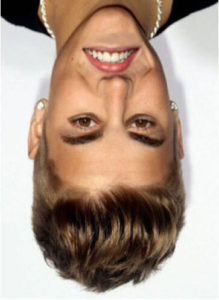
How about now?

The eyes, and the brain, can fall prey to a range of optical illusions, for a variety of reasons.
One such illusion is known as the Thatcher Effect. Named for former British Prime Minister Margaret Thatcher, since it was a photo of her that was famously used to illustrate the illusion, shows that the brain cannot properly process a photo of a face which is upside-down.
It demonstrates this by modifying upside down faces, flipping the mouth and eyes right side up. Because of this, and how our minds have learned to recognize faces, the brain believes nothing is wrong...until the image is turned right side up. Only at that point does the brain finally realize that yes, something was indeed very wrong with the image.
The Thatcher Effect demonstrates the importance of the brain’s processing of visual information, and the fact that recognizing faces is something we learn to do as our vision develops.
Read More
Optical illusions work by exploiting the disparity between what the eyes see and how the brain perceives that visual input. In doing so, they demonstrate that our visual systems “edit” what we see without us even being aware of it, as it decides what is worth paying attention to.
Even before humans understood the visual system as we do today, they created and were fascinated by optical illusions. Even today, we don’t know enough to explain how some of these fascinating illusions work.
Below are a few of these eye-twisting, and brain-fooling, illusions.
Lilac Chaser
Focus on the crosshairs in the center of the image. After around 10-20 seconds, the lilac colored dots will start fading away to gray, while the dot that had previously been hopping around the lilac chain becomes a green dot, rotating in a circle.
This illusion is called Troxler’s fading, or Troxler’s effect, and it was discovered by Swiss polymath Ignaz Paul Troxler in 1804. Troxler’s effect is a result of the ability of our visual neurons to turn off their awareness of things which aren’t changing, and to heighten their perception of things which are.
Since, in the animated image, the lilac dots are stationary while the empty spot moves, after a short processing period, our visual system transitions to focusing solely on the moving blank dot. Due to a second illusion at play, the moving blank dot turns green. That is due to the retinas of the eyes becoming oversaturated with the lilac color from the dots we saw moments ago.When the lilac color is removed, what you see is its complementary color (a light green) in its place. Essentially, the green color is the result of white light with the lilac color subtracted.
Gradient Illusion
 The bar in the center of the image above appears gradated, changing from light to dark gray in the opposite direction as the background gradient.
Have you guessed the illusion yet? Perhaps you have. This is a case of your brain fooling itself. If you cover everything in the image apart from the bar, you’ll confirm that it is actually monochrome.
This illusion is caused by the brain interpreting the ends of the bar as being in different lighting, and from that determines what it thinks the bar would look like if evenly lit. Through this process, it decides that the left end of the bar is a light gray object in dim lighting, while the right is a darker gray that is well lit.
The bar in the center of the image above appears gradated, changing from light to dark gray in the opposite direction as the background gradient.
Have you guessed the illusion yet? Perhaps you have. This is a case of your brain fooling itself. If you cover everything in the image apart from the bar, you’ll confirm that it is actually monochrome.
This illusion is caused by the brain interpreting the ends of the bar as being in different lighting, and from that determines what it thinks the bar would look like if evenly lit. Through this process, it decides that the left end of the bar is a light gray object in dim lighting, while the right is a darker gray that is well lit.
Disappearing Dots
For this illusion, start by staring at the blinking green light in the center of the video for several seconds. You’ll notice that as you continue staring, the yellow dots around the light. One of them might disappear, only to reappear moments later, or first one fades, then the other two, only for all 3 to come back after another few moments. As long as you keep focusing on the blinking light, the yellow dots continually disappear and reappear at random.
This illusion is called motion induced blindness, and it was first discovered in 1965, but it wasn’t until 2001, when it was rediscovered and named, that it gained significant attention. While similar to Troxler’s fading, which we touched on above, it is considered a separate phenomenon due to the requirement of a moving background for it to work.
There is still debate regarding the cause of motion induced blindness, with at least 5 theories being proposed.
One recent theory, known as the perceptual scotoma, proposes that this illusion is another attempt by the brain to provide us with clear and accurate perception. Since the 3 dots don’t change as the background spins, the visual system takes them out of our awareness, since they seem to be in contradiction with how the visual system understands things to work in real life. So, it essentially treats those spots like blind spots in the visual field.
The Hering Illusion

(Image credit: Fibonacci | Creative Commons)
This mind-bending illusion, first discovered in 1861 by German physiologist Ewald Hering, makes it look like the two straight red lines in fact bow outward. According to Hering, the reason for this illusion is that when we see the red lines crossing over the blue ones that radiate outward, our brains overestimate the angle made at the points where the red lines intersect the radiating ones.
Current research hypothesizes that the reason for this miscalculation is that since there is a delay between the time light hits the retina to when the brain perceives it, we evolved to compensate by generating images of what we think will occur one-tenth of a second in the future.
So in this case, that predicting leads to the overestimation of the angles, which makes the red lines look bent when they are truly straight. (And if you don’t believe it, cover up the blue lines and take another look at either of the red ones!)
The Checker Shadow Illusion
 On this checkerboard, the squares labeled A & B appear to be very different shades of gray, right? However, when we look at the board again, this time with solid gray lines running along both squares, we can see that they were the same shade all along!
This illusion, published by Edward H. Adelson, Professor of Vision Science at MIT in 1995, demonstrates how our visual system deals with shadows. When we try to determine the precise color of something, our brain knows that shadows can be misleading, in that they can make a surface look darker than it truly is. So the brain compensates by interpreting the shadowed surfaces as being lighter, even though it’s the exact same color as an unshadowed object which appears, at first glance, to be much darker.
On this checkerboard, the squares labeled A & B appear to be very different shades of gray, right? However, when we look at the board again, this time with solid gray lines running along both squares, we can see that they were the same shade all along!
This illusion, published by Edward H. Adelson, Professor of Vision Science at MIT in 1995, demonstrates how our visual system deals with shadows. When we try to determine the precise color of something, our brain knows that shadows can be misleading, in that they can make a surface look darker than it truly is. So the brain compensates by interpreting the shadowed surfaces as being lighter, even though it’s the exact same color as an unshadowed object which appears, at first glance, to be much darker.
Illusory Motion

(Image credit: Akiyoshi Kitaoka)
As hard as it might be to believe, nothing in this image is moving.
Unfortunately, there isn’t too much more we can tell you about this mind-boggling illusion.
To this day, there is no solid explanation for illusory motion. Some experts think it is linked to something called fixation jitter, involuntary eye movements which present the illusion that objects close to something you’re fixated on are moving.
Others believe that as you glance around the image, the motion detectors in your visual cortex get “confused” by dynamical changes in neurons, and thus believe that you are, in fact, seeing movement.
Illusions like this one serve to illustrate to us that while we know much, much more about vision than we did in the past, there is always more to learn!
These are just a few of the many fascinating optical illusions out there; demonstrations of just how fascinating our visual systems truly are.
Read More
There are always more fascinating optical illusions for us to puzzle over. Here are several more worth exploring.
The Spinning Dancer
 Chances are you’ve seen this one somewhere online. In this illusion, you see the silhouette of a dancer, spinning in place. The illusion involves the direction in which you see it spins. Sometimes it appears to rotate in a clockwise direction, and at other times, in a counterclockwise direction. The director in which the dancer spins can potentially be changed at will by the viewer, or it may appear to change direction on its own.
The spinning dancer illusion, created by Nobuyuki Kayahara in 2003, has since become one of the more well known optical illusions. The reason for the illusion is that the lack of visual depth in the animation, and ambiguity regarding the dancer’s anatomy are too ambiguous for our visual systems to process properly, so we can perceive the spinning dancer in differing, even conflicting states.
Chances are you’ve seen this one somewhere online. In this illusion, you see the silhouette of a dancer, spinning in place. The illusion involves the direction in which you see it spins. Sometimes it appears to rotate in a clockwise direction, and at other times, in a counterclockwise direction. The director in which the dancer spins can potentially be changed at will by the viewer, or it may appear to change direction on its own.
The spinning dancer illusion, created by Nobuyuki Kayahara in 2003, has since become one of the more well known optical illusions. The reason for the illusion is that the lack of visual depth in the animation, and ambiguity regarding the dancer’s anatomy are too ambiguous for our visual systems to process properly, so we can perceive the spinning dancer in differing, even conflicting states.
Rubin’s Vase
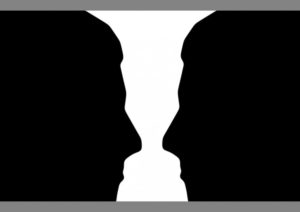 Another optical illusion you are likely to have run into before, the Rubin’s vase illusion, created by Edgar Rubin in 1915, is among the most famous optical illusions in the world. In the image, we see what can alternatively be a vase or two faces in profile, facing each other.
This illusion is explained through the concept of figure-ground organization. This lets us perceive objects both as figures and backgrounds. In this illusion, however, what we see alters with a change of perspective. If the black area is seen as the background, the vase becomes the figure. Conversely, when we see the white area as the background, the faces become the figure.
Another optical illusion you are likely to have run into before, the Rubin’s vase illusion, created by Edgar Rubin in 1915, is among the most famous optical illusions in the world. In the image, we see what can alternatively be a vase or two faces in profile, facing each other.
This illusion is explained through the concept of figure-ground organization. This lets us perceive objects both as figures and backgrounds. In this illusion, however, what we see alters with a change of perspective. If the black area is seen as the background, the vase becomes the figure. Conversely, when we see the white area as the background, the faces become the figure.
The Müller-Lyer Illusion
 Yet another illusion you’re likely to have run into before, this was created by Franz Carl Müller in 1889, and has become extremely recognizable.
In this illusion, you see three horizontal lines, each with differently configured arrowheads on the ends of the line. While the lines may look to be all of different lengths, they are, in fact, all equally long.
Interestingly, some studies show that Western individuals are more susceptible to this illusion, since they are more used to “carpentered” surroundings, meaning that they live and work in areas where straight lines and right angles are commonplace. One explanation for how this illusion works is that the differently aligned arrows make the lines look to be of different lengths. Inward pointing arrows make an object appear closer, while outward facing arrows appear further away. Since the lines are presented side by side, we perceive the “further away” line as longer.
Yet another illusion you’re likely to have run into before, this was created by Franz Carl Müller in 1889, and has become extremely recognizable.
In this illusion, you see three horizontal lines, each with differently configured arrowheads on the ends of the line. While the lines may look to be all of different lengths, they are, in fact, all equally long.
Interestingly, some studies show that Western individuals are more susceptible to this illusion, since they are more used to “carpentered” surroundings, meaning that they live and work in areas where straight lines and right angles are commonplace. One explanation for how this illusion works is that the differently aligned arrows make the lines look to be of different lengths. Inward pointing arrows make an object appear closer, while outward facing arrows appear further away. Since the lines are presented side by side, we perceive the “further away” line as longer.
The Ebbinghaus Illusion
 Another illusion which plays with our understanding of perspective, the Ebbinghaus illusion, also known as the Titchener Circles, was discovered by Hermann Ebbinhaus in the 19th century. This illusion challenges your perception of size. In the more common version of the illusion, created by Edward B. Titchener, we see two equally sized circles, one of which is surrounded by larger circles, and another surrounded by a ring of smaller circles.
Even though the circles are the same size, the one surrounded by bigger circles appears smaller than the one surrounded by smaller circles. The reason for this is believed to be related to how we perceive size, specifically, on the context involved. With the changed context in which we see the circles, our perception of their size also changes.
Another illusion which plays with our understanding of perspective, the Ebbinghaus illusion, also known as the Titchener Circles, was discovered by Hermann Ebbinhaus in the 19th century. This illusion challenges your perception of size. In the more common version of the illusion, created by Edward B. Titchener, we see two equally sized circles, one of which is surrounded by larger circles, and another surrounded by a ring of smaller circles.
Even though the circles are the same size, the one surrounded by bigger circles appears smaller than the one surrounded by smaller circles. The reason for this is believed to be related to how we perceive size, specifically, on the context involved. With the changed context in which we see the circles, our perception of their size also changes.
Kanizsa’s Triangle
 This optical illusion is a famous example of the concept of illusory contours. That refers to our perception of an edge or an outline where there isn’t one. This perception is created by different shapes and edges being presented together and arranged in a way that implies the presence of defined contours or edges.
In Kanizsa’s Triangle itself, the three incomplete black circles and open angles generate the illusion of a white triangle. As is usually the case with this type of illusion, the illusory shape appears both closer to the viewer, and brighter.
It works because the incomplete circles trigger our depth perception, causing our visual system to believe the dark shapes are further away and darker than the apparent triangle.
This optical illusion is a famous example of the concept of illusory contours. That refers to our perception of an edge or an outline where there isn’t one. This perception is created by different shapes and edges being presented together and arranged in a way that implies the presence of defined contours or edges.
In Kanizsa’s Triangle itself, the three incomplete black circles and open angles generate the illusion of a white triangle. As is usually the case with this type of illusion, the illusory shape appears both closer to the viewer, and brighter.
It works because the incomplete circles trigger our depth perception, causing our visual system to believe the dark shapes are further away and darker than the apparent triangle.
The Duck and Rabbit Illusion
 This illusion was first made in 1892, and has been fascinating people to this day.
The image we see can be alternatively viewed as a duck facing left, or a rabbit facing right, and the illusion operates on the concepts of how our visual system perceives ambiguous images, and the process of mid-level vision.
Mid-level vision is how our brains organize visual information based on the perceived edges of the image. With ambiguous images, the edges are unclear, and so we can perceive two contradictory versions of the same image depending on how we look at it.
There are many more fascinating optical illusions out there which can help us gain a better understanding of our visual system. And, of course, they’re just plain cool to look at.
This illusion was first made in 1892, and has been fascinating people to this day.
The image we see can be alternatively viewed as a duck facing left, or a rabbit facing right, and the illusion operates on the concepts of how our visual system perceives ambiguous images, and the process of mid-level vision.
Mid-level vision is how our brains organize visual information based on the perceived edges of the image. With ambiguous images, the edges are unclear, and so we can perceive two contradictory versions of the same image depending on how we look at it.
There are many more fascinating optical illusions out there which can help us gain a better understanding of our visual system. And, of course, they’re just plain cool to look at.
Read More
There’s a seemingly unending number of optical illusions that play on the limitations, and the tendencies, of our visual systems. Let’s explore a few more.
The Expanding Heart
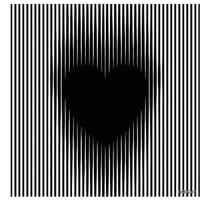 In the above image, the blakc heart looks like it’s constantly expanding! However, it never seems to get bigger, and it’s not a looped gif, so what’s going on?
This illusion plays on the fact that our eyes are constantly moving (if you don’t believe us, ask someone to track your eye movements for a bit.)
If we simply saw everything in real time, since our eyes constantly move, we’d have a hard time seeing anything comprehensible. To compensate for this, the brain “edits” all this compiled input into an image we can properly see, similar to how a good movie editor can seamlessly edit scenes together. Our brains also rely on the context of an object to effectively determine what it sees.
In the illusion here, the lined background is used by the brain as a reference point to orient the heart. Between the lines, and our eyes’ constant movement, the heart thus appears to be expanding.
In the above image, the blakc heart looks like it’s constantly expanding! However, it never seems to get bigger, and it’s not a looped gif, so what’s going on?
This illusion plays on the fact that our eyes are constantly moving (if you don’t believe us, ask someone to track your eye movements for a bit.)
If we simply saw everything in real time, since our eyes constantly move, we’d have a hard time seeing anything comprehensible. To compensate for this, the brain “edits” all this compiled input into an image we can properly see, similar to how a good movie editor can seamlessly edit scenes together. Our brains also rely on the context of an object to effectively determine what it sees.
In the illusion here, the lined background is used by the brain as a reference point to orient the heart. Between the lines, and our eyes’ constant movement, the heart thus appears to be expanding.
The Summer Spin
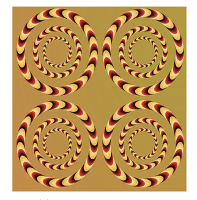 Another image that provides the illusion of movement, the spirals above appear to be slowly spinning by taking advantage of a phenomena known as apparent motion.
It takes one tenth of a second for signals from the retina to reach the brain, and if there is more contrast in what the brain is seeing, the faster the transmission. (For example, a higher contrast signal arrives one twentieth of a second faster than a low-contrast one.) So in this illusion, the contrast gradients are arranged in a way that tricks the brain into believing there is motion, as the high contrast parts of the image arrive faster than the rest.
Another image that provides the illusion of movement, the spirals above appear to be slowly spinning by taking advantage of a phenomena known as apparent motion.
It takes one tenth of a second for signals from the retina to reach the brain, and if there is more contrast in what the brain is seeing, the faster the transmission. (For example, a higher contrast signal arrives one twentieth of a second faster than a low-contrast one.) So in this illusion, the contrast gradients are arranged in a way that tricks the brain into believing there is motion, as the high contrast parts of the image arrive faster than the rest.
Impossible Shapes
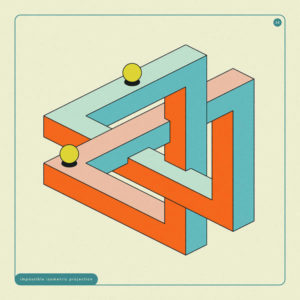 There are several different images that illustrate this phenomenon, but they all fall into the same general group of impossible shapes. The image depicts an object which, at first glance, appears realistic, but upon closer inspection, its mind twisting nature becomes clear as we realize that this shape could never exist in a real, 3D form.
This illusion is related to the Gestalt laws, which describe how we see and interpret the world around us, with everything being parts of a single image. So we see, in complex scenes, objects against a background, and those objects themselves are made of parts, which in turn are made of smaller parts.
According to one of these Gestalt laws, when we see ambiguous or complex objects, the brain tries to make them look as simple as it can. That is why our brain tries to ignore the impossibility of this shape, enabling us to process the image, and once we force it to acknowledge the impossibility of the shape, it becomes an eye-twisting anomaly.
There is always more to be learned about the visual system, and illusions like these always demonstrate that what we see might not always be what’s actually in front of us.
There are several different images that illustrate this phenomenon, but they all fall into the same general group of impossible shapes. The image depicts an object which, at first glance, appears realistic, but upon closer inspection, its mind twisting nature becomes clear as we realize that this shape could never exist in a real, 3D form.
This illusion is related to the Gestalt laws, which describe how we see and interpret the world around us, with everything being parts of a single image. So we see, in complex scenes, objects against a background, and those objects themselves are made of parts, which in turn are made of smaller parts.
According to one of these Gestalt laws, when we see ambiguous or complex objects, the brain tries to make them look as simple as it can. That is why our brain tries to ignore the impossibility of this shape, enabling us to process the image, and once we force it to acknowledge the impossibility of the shape, it becomes an eye-twisting anomaly.
There is always more to be learned about the visual system, and illusions like these always demonstrate that what we see might not always be what’s actually in front of us.
Read More
We’ve all run into optical or visual illusions at some point, especially in the age of the internet. There are many famous ones which we’d recognize on sight, even if we don’t know their names.
But how do these eye and mind-bending illusions work? Are our eyes the ones being fooled, or is it more the brain & the broader visual system itself?
Here, we’ll look at 3 types of optical illusions
- Cognitive Illusions
- Physiological Optical Illusions
- Literal Optical Illusions
Cognitive Illusions
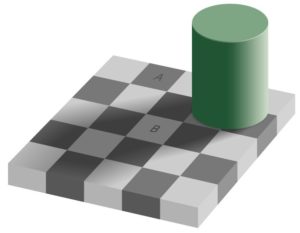 Cognitive illusions generally show an ambiguous image, and they are caused by a phenomenon known as unconscious inferences, which are made by the brain when looking at ambiguous images. Specifically, with these illusions, the brain infers the presence of an object which doesn’t actually exist.
In one well known example of a cognitive illusion, known as Kanizsa’s Triangle, we perceive a white triangle inside the partial black circles. This is due to the positioning of the pac-man shaped black circles. It looks like a triangle fits in there, and the contrast also implies a bright white triangle, so our brain takes the extra step by actually “seeing” it, inferring its presence despite it not truly being there.
Cognitive illusions generally show an ambiguous image, and they are caused by a phenomenon known as unconscious inferences, which are made by the brain when looking at ambiguous images. Specifically, with these illusions, the brain infers the presence of an object which doesn’t actually exist.
In one well known example of a cognitive illusion, known as Kanizsa’s Triangle, we perceive a white triangle inside the partial black circles. This is due to the positioning of the pac-man shaped black circles. It looks like a triangle fits in there, and the contrast also implies a bright white triangle, so our brain takes the extra step by actually “seeing” it, inferring its presence despite it not truly being there.
Physiological Optical Illusions
 This type of illusion occurs when our eyes take in an excessive amount of visual stimuli for a period of time, and it has an effect on our eyes or brain. Brightness, color, or light flashes can all cause such illusions.
We can illustrate this with the image below. Stare at the image for about 15-20 seconds, then look over at the blank white space while blinking. You’ll see an image there now!
Since we spent a significant amount of time exposing our eyes to the initial images, the photoreceptor cells in the retinas keep sending neural impulses based on that to the brain even once we’ve stopped looking at the image, resulting in what we see in the blank space, known as an afterimage.
You may have experienced something similar if you’ve ever looked at the sun for a moment (try not to do that), or looked at some other very bright light. For a short time afterward, while blinking, you’ll see an object in the shape of that bright light, because your eyes have just been overexposed.
This type of illusion occurs when our eyes take in an excessive amount of visual stimuli for a period of time, and it has an effect on our eyes or brain. Brightness, color, or light flashes can all cause such illusions.
We can illustrate this with the image below. Stare at the image for about 15-20 seconds, then look over at the blank white space while blinking. You’ll see an image there now!
Since we spent a significant amount of time exposing our eyes to the initial images, the photoreceptor cells in the retinas keep sending neural impulses based on that to the brain even once we’ve stopped looking at the image, resulting in what we see in the blank space, known as an afterimage.
You may have experienced something similar if you’ve ever looked at the sun for a moment (try not to do that), or looked at some other very bright light. For a short time afterward, while blinking, you’ll see an object in the shape of that bright light, because your eyes have just been overexposed.
Literal Optical Illusions
 Literal optical illusions are when our eyes perceive an image, and our mind fills in gaps in the image which don’t exist. This leads to the creation of an image different from the objects which make up that image, or it focuses in on certain areas of the image, leading to us perceiving something that isn’t truly there.
In the image here, it looks like the elephant has way too many legs. This is because our eyes rely on the edges of objects to distinguish it, and in the example, the shading and especially the lines that make up the elephant confuse our eyes.
This phenomenon is also what leads us to “see” faces in everyday objects, since we’ve also learned to recognize faces, so our brains tend to find them even when they might not actually be present.
These, and other illusions, demonstrate that our brain plays a major role in vision, as it interprets the input that comes from the eyes based on how it’s learned to understand and organize the world around us. And since this is almost entirely done unconsciously, it is susceptible to being fooled or confused when our conscious examination of something conflicts with the brain’s initial assessment.
Unlike some of our senses, vision is very much learned, and studying and experiencing these illusions helps us better understand that process, along with our visual system as a whole.
Literal optical illusions are when our eyes perceive an image, and our mind fills in gaps in the image which don’t exist. This leads to the creation of an image different from the objects which make up that image, or it focuses in on certain areas of the image, leading to us perceiving something that isn’t truly there.
In the image here, it looks like the elephant has way too many legs. This is because our eyes rely on the edges of objects to distinguish it, and in the example, the shading and especially the lines that make up the elephant confuse our eyes.
This phenomenon is also what leads us to “see” faces in everyday objects, since we’ve also learned to recognize faces, so our brains tend to find them even when they might not actually be present.
These, and other illusions, demonstrate that our brain plays a major role in vision, as it interprets the input that comes from the eyes based on how it’s learned to understand and organize the world around us. And since this is almost entirely done unconsciously, it is susceptible to being fooled or confused when our conscious examination of something conflicts with the brain’s initial assessment.
Unlike some of our senses, vision is very much learned, and studying and experiencing these illusions helps us better understand that process, along with our visual system as a whole.
Read More
 Optical illusions are one of the best reminders that vision is a system made up of more than just the eyes. It’s the brain that organizes the input it receives and determines what we see. Optical illusions take advantage of how our visual system works to create the mind-bending visuals we’ve all run into at some point.
Here is a look into another couple optical illusions
Optical illusions are one of the best reminders that vision is a system made up of more than just the eyes. It’s the brain that organizes the input it receives and determines what we see. Optical illusions take advantage of how our visual system works to create the mind-bending visuals we’ve all run into at some point.
Here is a look into another couple optical illusions
The Chubb Illusion
 This illusion was discovered by Charles Chubb and his colleagues Sperling and Solomon in the late 1980s, during experiments with perceived contrast. In the image here, the gray circle on the simple gray background and the gray circle on the black and white, textured background, are identical, despite appearing to us as different shades of gray.
This can be explained through the concept of imperfect transmittance, which is where the brain has to see through ambiguity in order to perceive an object. (More practical examples are when we look at something from a distance or through fog.) When there is minimal light around the object, the brain attempts to determine its color and contrast by making an educated guess based on the background around the object.
As is the case here, that interpretation isn’t always correct.
This illusion was discovered by Charles Chubb and his colleagues Sperling and Solomon in the late 1980s, during experiments with perceived contrast. In the image here, the gray circle on the simple gray background and the gray circle on the black and white, textured background, are identical, despite appearing to us as different shades of gray.
This can be explained through the concept of imperfect transmittance, which is where the brain has to see through ambiguity in order to perceive an object. (More practical examples are when we look at something from a distance or through fog.) When there is minimal light around the object, the brain attempts to determine its color and contrast by making an educated guess based on the background around the object.
As is the case here, that interpretation isn’t always correct.
The Poggendorff Illusion
 Take a look at the image here. Does the black line look like it lines up with the blue line? The truth is, the black line lines up with the red one, as the second image reveals.
This illusion is named for Johann Poggendorff, the German physicist who first detailed this illusion in 1860. While it is clearly a demonstration of how our minds perceive depth and geometric shapes, there is no universally accepted explanation for it.
The most widely accepted theory, however, is that in this illusion our brain is trying to interpret the two dimensional image with three dimensional properties, and in the process it’s distorting the depth between the lines.
Take a look at the image here. Does the black line look like it lines up with the blue line? The truth is, the black line lines up with the red one, as the second image reveals.
This illusion is named for Johann Poggendorff, the German physicist who first detailed this illusion in 1860. While it is clearly a demonstration of how our minds perceive depth and geometric shapes, there is no universally accepted explanation for it.
The most widely accepted theory, however, is that in this illusion our brain is trying to interpret the two dimensional image with three dimensional properties, and in the process it’s distorting the depth between the lines.
Shepard’s Table
 The Shepard’s Table illusion was first created by American psychologist Robert Shepard in a book he published in 1990, and provides yet more evidence that our visual system is primarily influenced by our lived experiences with the world around us, to the point where it can mess with our view of reality.
In the image here, the two tables look to be of very different size and shape. In actuality, they are exactly the same! This animated illustration can prove it to you.
This is another illusion caused by the fact that our brain tries to interpret 2D images in the same way it interprets 3D ones. It perceives different sizes because of perspective foreshortening, which means that the closer an object is, the larger it appears on the retina.
Optical illusions are endlessly fascinating, both because they’re simply interesting to look at, and because they can teach us a lot about the visual system. Go explore some more optical illusions!
The Shepard’s Table illusion was first created by American psychologist Robert Shepard in a book he published in 1990, and provides yet more evidence that our visual system is primarily influenced by our lived experiences with the world around us, to the point where it can mess with our view of reality.
In the image here, the two tables look to be of very different size and shape. In actuality, they are exactly the same! This animated illustration can prove it to you.
This is another illusion caused by the fact that our brain tries to interpret 2D images in the same way it interprets 3D ones. It perceives different sizes because of perspective foreshortening, which means that the closer an object is, the larger it appears on the retina.
Optical illusions are endlessly fascinating, both because they’re simply interesting to look at, and because they can teach us a lot about the visual system. Go explore some more optical illusions!
Read More
We’ve all encountered optical illusions at one point or another; but the thing you’ve likely wondered is: How do they work? How do they trick us into seeing something different from what is actually in front of us?
While nearly all optical illusions take advantage of the way our minds have learned to interpret the world around us, different types of illusions demonstrate different things about our visual system.
However, here we’ll just be going a bit deeper into the general idea of how our brain can be fooled by visual input.
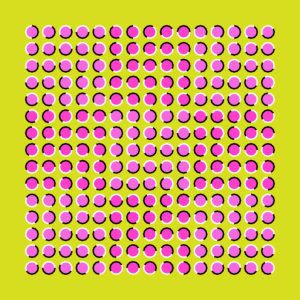
The Brain-Eye Connection
As smart as our brain is (and it is smarter than many give it credit for), it cannot see on its own, relying on visual input from the eyes. However, the eyes function more like cameras, and aren’t capable of always effectively conveying complex visuals to the brain. So, at times, the brain gets confused.
This confusion can lead the brain to making mistakes like thinking something is moving when it is not, or “seeing” colors or shapes which aren’t actually there.
For one example, look at the image below.
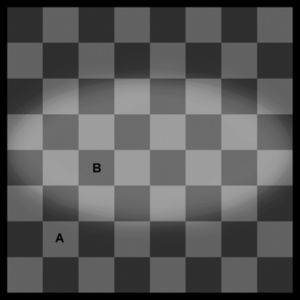 The two squares marked A and B are the same shade of gray, despite how it may appear. This is due to our brain trying to determine the color by looking at the other squares around them.
The two squares marked A and B are the same shade of gray, despite how it may appear. This is due to our brain trying to determine the color by looking at the other squares around them.
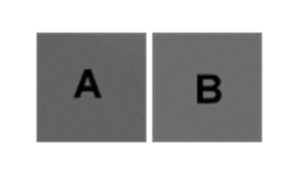
Filling in the Blanks
Because of the simple means of communication between the eyes and the brain, sometimes there is information that can’t get accurately communicated, so the brain makes its best guess based on what information it has received from the eyes. Most of the time, it’s correct.
But sometimes those guesses are wrong, due to the imperfect communication.
An Ongoing Mystery
Despite a great deal of research by many scientists into exactly how these illusions work, for many, we don’t know how the brain-eye link creates them. We do know now that the path the information from our eyes takes to get to the brain is rather long and complex, so confusion can arise at any stage of that journey. Generally, illusions in which the confusion arises later in that journey, the less we know about exactly why and how it happens.
However, more research is being done all the time, so maybe one day someone--perhaps even you!--will finally solve the mystery.
Read More
Here's a fun game to play with children that is also an excellent way to practice several hand-eye coordination skills that are useful for such varied activities as reading, writing, note-taking, and playing sports. It comes courtesy of developmental optometrist, Dr. Julie Steinhaeur of Vision For Life.
How to play the "Bubble Pop" game:
- Purchase a bottle of children's play bubbles.
- Blow bubbles!
- Have the kids poke/pop them with their fingers, or with a thin "pick-up" type stick, which works on even more refined motor skills. This way the game becomes even more fun while simultaneously becoming an even more effective way to work on visual motor activity.
- Repeat steps 2 and 3.
- Come up with your own variations of the game, such as trying to catch the bubbles on a spoon or in a cup, or using different wands to blow a variety of bubble sizes. Bubble size presents different challenges. A tiny bubble poses a greater challenge for little children than an oversized one. Pretend to be mosquitos popping the bubbles. Use your imagination!
The Benefits of Bubble Popping
Popping bubbles is an excellent way to have fun while working on such critical visual-motor skills as:
- Depth perception skills: This exercise requires depth perception to locate the bubble in space in relation to the child's body.
- Fine motor control skills: This game requires a child to successfully coordinate small muscles to perform fine, close-up work.
- Visual tracking skills: It takes refined eye tracking skills to find the bubble as it floats through the air, and then coordinate the visual-motor control to pop it.
- Social skills: The more the merrier. The game becomes more fun as little children interact and work together to pop the balloons. The benefit of social skills is only one of many critical skills that can be improved with such activities.
Astigmatism is an eye condition which causes blurry or distorted vision. Continue reading to learn more about what causes astigmatism, and how it is treated.
What Causes Astigmatism?
Astigmatism is a refractive error in the eye (similar to myopia--nearsightedness, and hyperopia--farsightedness.) Astigmatism is characterized by unequal curvatures in the lens or cornea. This irregular eye shape leads to blurry vision. According to the American Optometric Association (AOA), most people have some amount of astigmatism, though in many cases it is small enough so as not to be noticeable. Astigmatism can be present from birth or develop later on, and the degree of astigmatism in your eyes can both increase or decrease over time.
Diagnosis and Treatment of Astigmatism
In order to receive a proper diagnosis of astigmatism, you must see an eye doctor for a proper eye exam. During this test, the doctor will measure your eyeball and identify places on the lens or cornea that are causing your astigmatism. Once the test is complete, you will receive your diagnosis, and the doctor will help you prepare a treatment plan.
As with other refractive errors, you can wear eyeglasses or contact lenses to correct astigmatism. If you do not wish to wear glasses or contact lenses, and your astigmatism isn’t too severe, you can consider the surgical route and look into LASIK.
At-Home Exercises Which Can Help Treat Astigmatism
In addition to wearing your glasses or contacts, there are some exercises you can do anywhere that can help treat the symptoms of astigmatism, and may even improve your vision. One exercise commonly used to relieve eye strain is the “20-20-20 Rule”. This entails taking a break for 20 seconds after every 20 minutes spent reading, writing, or looking at a screen to stare at an object 20 feet away.
You can also massage your eye. This is done by placing two fingers on each eyelid, applying gentle pressure, and moving your fingers, slowly, in a circular motion. Alternate between clockwise and counterclockwise.
Read More
Spot It is a fun and educational visual game that comes in many forms and can be used in various ways. There is a version of the game that is suitable for players as young as three years old and up. It is played in groups of two to eight players and there are different themes for the kinds of symbols found in each game. For example, there are some versions that come with images, others with numbers or alphabet, etc. There’s approximately six different games you could play with just one package of Spot It.
The main game is played by identifying matching symbols in different cards which are each filled with a variety of symbols making it challenging to find matching images.
How does Spot It improve your child's vision?
Spot It can help develop different visual skills, including:
- Visual memory
- Visual discrimination
- Visual figure ground perception (this is when one is able to find the forest from the trees)
- Other visual analysis skills
This game is a wonderful example of how educational certain visual activities can be as it helps train our brain and eyes to work together as a team in order to sharpen some important visual skills.
Keratoconus is an eye disorder that causes the cornea to become thinner and more cone shaped. The cornea is the clear layer that covers the front of the eye and contributes greatly to how we see. This corneal disorder causes a lot of visual disturbances due to the progressive thinning and change in shape of the cornea.
If you’ve been diagnosed with keratoconus, there could be a lot of new information to take in which may be confusing. We’d like to debunk some common myths about keratoconus.
Keratoconus is only diagnosed in young people
Age is not a risk factor and anyone can develop keratoconus at any age. It is most common for people to develop keratoconus in their teens and it often continues progressing into the thirties.
Keratoconus causes blindness
This corneal disorder can cause significant visual impairment, and there are cases where it could lead to blindness. However, that being said, keratoconus does not automatically cause blindness and many people with this condition are able to still see, using various optical corrections such as contact lenses or surgical procedures. If keratoconus progresses to the point where there is excessive corneal scarring and the patient can no longer tolerate contact lenses, then there may be a need for a corneal transplant.
The only treatment for keratoconus is corneal transplant
Corneal transplants are the very last resort for extreme cases when no other methods of treatment are sustainable. There are many other effective methods that are used prior to the last option of a transplant. There are a variety of contact lenses ranging from soft lenses to sclerals which allow people with keratoconus to see more clearly. In addition, there are successful procedures such as cross-linking and conductive keratoplasty.
Cross linking cannot be performed over age 40
Age is not a contraindication for this surgery, and therefore it can be performed on patients over age forty. Each individual patient needs to be checked if they are an eligible candidate for this procedure. Cross linking is a minimally invasive method which uses ultraviolet light and eye drops to strengthen the fibers in the cornea. This surgery is the only method that prevents progressive keratoconus from getting worse, as it stabilizes the cornea and slows down the bulging. It has been reported to have a 95% success rate.
If you have any questions about keratoconus, please don’t hesitate to schedule an appointment at our office. Our professional staff will gladly answer all of your questions.
Read More
There are various exercises that prove to be very useful for certain eye conditions, such as stretching the eye muscles.
For example, if someone has crossed eyes, specifically if the eye is turned in too much, otherwise known as over converging, then there is an effective activity that can train the eyes to correct this misalignment. In such a case, there are certain movements when the eyes move out to the extremities which can make the eyes feel very tight. It’s important to strengthen the eye movements in those directions by training the eyes to be able to look that way and overcome the resistance.
There is an exercise which uses occluders to cover both eyes extending past the eyes so they are really well covered. The patient is given the challenge of looking around the occluders which gives them the opportunity to stretch their eye muscles to look out to the extremities and strengthen those tight muscles.
Read More
Innovation, especially where it comes to treatment options for people undergoing vision therapy, can be a great help. More so if that innovation is something easy to do, and requires little more than a tool already in the box.
The Brock string, a commonly used tool in vision therapy, consists of a flexible white cord or string around 10-15 feet in length and colored wooden beads which can be moved along the length of the string.
Typically, it is used to test the ability of the eyes to focus on an object at various distances and therefore useful in working with patients who have issues like convergence insufficiency, amblyopia (lazy eye), and strabismus.
However, a clever modification to the familiar brock string can also be useful to help patients work on their peripheral vision.
This works by adding a clear plastic disk onto the string, and on this disk are two black rings, one on the inside and the other on the outside. As the patient focuses on the bead, they can try to keep the rings on the disk in their peripheral vision.
This helps with the process of going from central to peripheral organization of information, something which is extremely important for things like reading and sports.
A clever new use for a well known tool!
Read More
Can I Sleep With My Contact Lenses?
This may sound like a trick question. Many contact lens wearers will probably answer the question by acknowledging that it can be dangerous to sleep with lenses unless they are designed for overnight usage. But is this accurate?
Sleeping With "Overnight" Lenses: Is It Wise?
Many extended wear contacts are marketed as safe for overnight wear. The truth is that most experts advise against sleeping with ANY type of lens. Many even advise against taking short naps with them.
Studies have shown that even with gas-permeable, silicone, hydrogel lenses designed to improve oxygen flow to the eye, the risk of eye infections from overnight wear is 5-8 times higher. With such a risk, it is evident why many optometrists feel this way.
Signs of Infection
Common symptoms of infection include:
- Pain, irritation, itchiness, and discomfort
- Redness, swelling, discharge, crustiness, and tearing
- Difficulty with blurred/hazy vision
- Difficulty or sensitivity with light or glare
- A sense that something is trapped under the eyelid
If symptoms persist or worsen, speak with an optometrist right away. Part of the risk of infection is that it can lead to more severe eye complications such as ulceration. It is critical that infections are diagnosed and treated early.
Treating Eye Infection
Eye infections may be treated with the following measures:
- Medicated bacterial eye drops for bacterial infection
- Antifungal treatments
- Careful debriding of the eye
- Steroid or corticosteroid treatment
Maintaining Good Habits
Always maintain good habits and hygienic standards for wearing and managing contacts. If you have questions, speak with an optometrist to find out more about appropriate practices. Optimal practices include:
- Properly sterilizing contacts and lens cases with an appropriate lens solution. Never use tap water to clean lenses.
- Never sleeping with any type of contact lens, all of which pose a risk factor for eye infections. All contacts reduce oxygen flow to the eye.
Caring For Our Eyes
Healthy eyes require optimal moisturization and flow of oxygen to the eye. Wearing contacts overnight impedes oxygen flow to the eyes, which makes them susceptible to bacterial and corneal infections. Left untreated, they may result in ulceration and in extreme cases, cause permanent vision loss.
That is why most eye care professionals strongly advise against sleeping with contacts, including those that are deemed safe for overnight usage. The perceived benefit of not having to remove them, is not worth the risk of infection and complications that can damage vision.
Speak to your eye doctor about the risks of sleeping with extended wear lenses. If you have slept with them for a short or extended period of time, or are having difficulty removing them after wearing them overnight, speak with an optometrist right away to find out how to proceed. Never forcefully attempt to remove contacts that are stuck.
Always report signs of eye infections right away to begin early treatment and prevent further eye complications.
Read More
Keratoconus is a progressive disorder in the cornea of the eye. The cornea is the transparent layer that covers the front of the eye and contributes greatly to how well we see. In keratoconus, the cornea becomes thinner and protrudes into a more cone shaped structure which causes a lot of visual disturbances. It usually affects both eyes, but often one eye starts progressing earlier or has a more serious condition than the other. It most commonly affects people aged 10 to 25 and it progresses over around a decade.
Symptoms
The typical symptoms and signs of keratoconus include:
- Blurry distorted vision
- Sudden decrease in vision
- Constant need to change prescription in glasses
- Light sensitivity and glare
Treatment Options
At the very early stages of keratoconus, glasses or soft contact lenses can be an appropriate optical correction but as the condition progresses, these options do not usually provide sufficient correction for people with keratoconus. Patients with keratoconus used to be given hard contact lenses which turned out to be extremely uncomfortable for the shape of their cornea.
Scleral Lenses
Nowadays we have a wonderful optical correction using scleral lenses, which is unique because as opposed to sitting on the cornea, as most lenses do, it sits on the sclera, which is the white part of the eye. This makes this type of lens very comfortable and it prevents the eyelashes from causing discomfort every time the patient blinks.
Surgical Options
There are surgical methods, including cross linking which stabilizes the fibers in the cornea and can be combined with other refractive methods.
When to See the Eye Doctor
If you have any questions or concerns about keratoconus, please schedule an appointment at our office. Our professional staff has extensive experience diagnosing and treating keratoconus.
When most of us think of vision issues, we think of the obvious: clear difficulty seeing either near or far objects. However, there is no shortage of vision issues that are much less obvious, and which can be present even if your child passes their in-school vision test and has 20/20 vision.
For this reason, it is important for your child to have regular comprehensive eye exams. It is also important to know the signs of potential issues. While they might be more difficult to spot, if you know what to look for, you are likely to pick up on them
Frequent Headaches
If your child experiences regular headaches, there is a chance it is due to eye strain as they struggle to focus on either near or far objects. This is often accompanied by squinting, which can provide a little help focusing.
Head Tilting
If your child frequently tilts their head to the side, it can signify an eye alignment issue. The tilting of the head can somewhat correct this issue, and allow them to see better. This symptom can be a sign of strabismus (lazy eye). In addition to this vision issue making it more difficult to see, it can harm their self-esteem in the classroom, if other students find their head tilting strange.
Poor Attention Span
If you notice your child quickly loses interest in activities, schoolwork, or sports (all things which require heavy eye usage for extended periods of time), it can be a sign of an underlying vision issue. This symptom can be a tricky one, as poor attention span is also a symptom of developmental disorders like ADHD. A comprehensive eye exam can conclusively tell you whether your child’s attention span issue is vision-related.
If undetected, vision issues can become more of a hindrance to your child over time, and it can also lead to them being mistakenly thought to have a condition such as ADHD. Being aware of these signs of potential vision problems, and catching them early, can be a huge help to a child presumably already having a more difficult time than most in school, sports, and other activities.
Vision therapy is extremely effective at treating these vision issues and enabling your child to both perform well in, and enjoy, their time in school. If you suspect your child may have a vision issue, be sure to schedule a comprehensive vision exam.
Read More

 The eyes, and the brain, can fall prey to a range of optical illusions, for a variety of reasons.
One such illusion is known as the Thatcher Effect. Named for former British Prime Minister Margaret Thatcher, since it was a photo of her that was famously used to illustrate the illusion, shows that the brain cannot properly process a photo of a face which is upside-down.
It demonstrates this by modifying upside down faces, flipping the mouth and eyes right side up. Because of this, and how our minds have learned to recognize faces, the brain believes nothing is wrong...until the image is turned right side up. Only at that point does the brain finally realize that yes, something was indeed very wrong with the image.
The Thatcher Effect demonstrates the importance of the brain’s processing of visual information, and the fact that recognizing faces is something we learn to do as our vision develops.
The eyes, and the brain, can fall prey to a range of optical illusions, for a variety of reasons.
One such illusion is known as the Thatcher Effect. Named for former British Prime Minister Margaret Thatcher, since it was a photo of her that was famously used to illustrate the illusion, shows that the brain cannot properly process a photo of a face which is upside-down.
It demonstrates this by modifying upside down faces, flipping the mouth and eyes right side up. Because of this, and how our minds have learned to recognize faces, the brain believes nothing is wrong...until the image is turned right side up. Only at that point does the brain finally realize that yes, something was indeed very wrong with the image.
The Thatcher Effect demonstrates the importance of the brain’s processing of visual information, and the fact that recognizing faces is something we learn to do as our vision develops.
 The bar in the center of the image above appears gradated, changing from light to dark gray in the opposite direction as the background gradient.
Have you guessed the illusion yet? Perhaps you have. This is a case of your brain fooling itself. If you cover everything in the image apart from the bar, you’ll confirm that it is actually monochrome.
This illusion is caused by the brain interpreting the ends of the bar as being in different lighting, and from that determines what it thinks the bar would look like if evenly lit. Through this process, it decides that the left end of the bar is a light gray object in dim lighting, while the right is a darker gray that is well lit.
The bar in the center of the image above appears gradated, changing from light to dark gray in the opposite direction as the background gradient.
Have you guessed the illusion yet? Perhaps you have. This is a case of your brain fooling itself. If you cover everything in the image apart from the bar, you’ll confirm that it is actually monochrome.
This illusion is caused by the brain interpreting the ends of the bar as being in different lighting, and from that determines what it thinks the bar would look like if evenly lit. Through this process, it decides that the left end of the bar is a light gray object in dim lighting, while the right is a darker gray that is well lit.
 (Image credit: Fibonacci | Creative Commons)
This mind-bending illusion, first discovered in 1861 by German physiologist Ewald Hering, makes it look like the two straight red lines in fact bow outward. According to Hering, the reason for this illusion is that when we see the red lines crossing over the blue ones that radiate outward, our brains overestimate the angle made at the points where the red lines intersect the radiating ones.
Current research hypothesizes that the reason for this miscalculation is that since there is a delay between the time light hits the retina to when the brain perceives it, we evolved to compensate by generating images of what we think will occur one-tenth of a second in the future.
So in this case, that predicting leads to the overestimation of the angles, which makes the red lines look bent when they are truly straight. (And if you don’t believe it, cover up the blue lines and take another look at either of the red ones!)
(Image credit: Fibonacci | Creative Commons)
This mind-bending illusion, first discovered in 1861 by German physiologist Ewald Hering, makes it look like the two straight red lines in fact bow outward. According to Hering, the reason for this illusion is that when we see the red lines crossing over the blue ones that radiate outward, our brains overestimate the angle made at the points where the red lines intersect the radiating ones.
Current research hypothesizes that the reason for this miscalculation is that since there is a delay between the time light hits the retina to when the brain perceives it, we evolved to compensate by generating images of what we think will occur one-tenth of a second in the future.
So in this case, that predicting leads to the overestimation of the angles, which makes the red lines look bent when they are truly straight. (And if you don’t believe it, cover up the blue lines and take another look at either of the red ones!)
 On this checkerboard, the squares labeled A & B appear to be very different shades of gray, right? However, when we look at the board again, this time with solid gray lines running along both squares, we can see that they were the same shade all along!
This illusion, published by Edward H. Adelson, Professor of Vision Science at MIT in 1995, demonstrates how our visual system deals with shadows. When we try to determine the precise color of something, our brain knows that shadows can be misleading, in that they can make a surface look darker than it truly is. So the brain compensates by interpreting the shadowed surfaces as being lighter, even though it’s the exact same color as an unshadowed object which appears, at first glance, to be much darker.
On this checkerboard, the squares labeled A & B appear to be very different shades of gray, right? However, when we look at the board again, this time with solid gray lines running along both squares, we can see that they were the same shade all along!
This illusion, published by Edward H. Adelson, Professor of Vision Science at MIT in 1995, demonstrates how our visual system deals with shadows. When we try to determine the precise color of something, our brain knows that shadows can be misleading, in that they can make a surface look darker than it truly is. So the brain compensates by interpreting the shadowed surfaces as being lighter, even though it’s the exact same color as an unshadowed object which appears, at first glance, to be much darker.
 (Image credit: Akiyoshi Kitaoka)
As hard as it might be to believe, nothing in this image is moving.
Unfortunately, there isn’t too much more we can tell you about this mind-boggling illusion.
To this day, there is no solid explanation for illusory motion. Some experts think it is linked to something called fixation jitter, involuntary eye movements which present the illusion that objects close to something you’re fixated on are moving.
Others believe that as you glance around the image, the motion detectors in your visual cortex get “confused” by dynamical changes in neurons, and thus believe that you are, in fact, seeing movement.
Illusions like this one serve to illustrate to us that while we know much, much more about vision than we did in the past, there is always more to learn!
These are just a few of the many fascinating optical illusions out there; demonstrations of just how fascinating our visual systems truly are.
(Image credit: Akiyoshi Kitaoka)
As hard as it might be to believe, nothing in this image is moving.
Unfortunately, there isn’t too much more we can tell you about this mind-boggling illusion.
To this day, there is no solid explanation for illusory motion. Some experts think it is linked to something called fixation jitter, involuntary eye movements which present the illusion that objects close to something you’re fixated on are moving.
Others believe that as you glance around the image, the motion detectors in your visual cortex get “confused” by dynamical changes in neurons, and thus believe that you are, in fact, seeing movement.
Illusions like this one serve to illustrate to us that while we know much, much more about vision than we did in the past, there is always more to learn!
These are just a few of the many fascinating optical illusions out there; demonstrations of just how fascinating our visual systems truly are.  Chances are you’ve seen this one somewhere online. In this illusion, you see the silhouette of a dancer, spinning in place. The illusion involves the direction in which you see it spins. Sometimes it appears to rotate in a clockwise direction, and at other times, in a counterclockwise direction. The director in which the dancer spins can potentially be changed at will by the viewer, or it may appear to change direction on its own.
The spinning dancer illusion, created by Nobuyuki Kayahara in 2003, has since become one of the more well known optical illusions. The reason for the illusion is that the lack of visual depth in the animation, and ambiguity regarding the dancer’s anatomy are too ambiguous for our visual systems to process properly, so we can perceive the spinning dancer in differing, even conflicting states.
Chances are you’ve seen this one somewhere online. In this illusion, you see the silhouette of a dancer, spinning in place. The illusion involves the direction in which you see it spins. Sometimes it appears to rotate in a clockwise direction, and at other times, in a counterclockwise direction. The director in which the dancer spins can potentially be changed at will by the viewer, or it may appear to change direction on its own.
The spinning dancer illusion, created by Nobuyuki Kayahara in 2003, has since become one of the more well known optical illusions. The reason for the illusion is that the lack of visual depth in the animation, and ambiguity regarding the dancer’s anatomy are too ambiguous for our visual systems to process properly, so we can perceive the spinning dancer in differing, even conflicting states.
 Another optical illusion you are likely to have run into before, the Rubin’s vase illusion, created by Edgar Rubin in 1915, is among the most famous optical illusions in the world. In the image, we see what can alternatively be a vase or two faces in profile, facing each other.
This illusion is explained through the concept of figure-ground organization. This lets us perceive objects both as figures and backgrounds. In this illusion, however, what we see alters with a change of perspective. If the black area is seen as the background, the vase becomes the figure. Conversely, when we see the white area as the background, the faces become the figure.
Another optical illusion you are likely to have run into before, the Rubin’s vase illusion, created by Edgar Rubin in 1915, is among the most famous optical illusions in the world. In the image, we see what can alternatively be a vase or two faces in profile, facing each other.
This illusion is explained through the concept of figure-ground organization. This lets us perceive objects both as figures and backgrounds. In this illusion, however, what we see alters with a change of perspective. If the black area is seen as the background, the vase becomes the figure. Conversely, when we see the white area as the background, the faces become the figure.
 Yet another illusion you’re likely to have run into before, this was created by Franz Carl Müller in 1889, and has become extremely recognizable.
In this illusion, you see three horizontal lines, each with differently configured arrowheads on the ends of the line. While the lines may look to be all of different lengths, they are, in fact, all equally long.
Interestingly, some studies show that Western individuals are more susceptible to this illusion, since they are more used to “carpentered” surroundings, meaning that they live and work in areas where straight lines and right angles are commonplace. One explanation for how this illusion works is that the differently aligned arrows make the lines look to be of different lengths. Inward pointing arrows make an object appear closer, while outward facing arrows appear further away. Since the lines are presented side by side, we perceive the “further away” line as longer.
Yet another illusion you’re likely to have run into before, this was created by Franz Carl Müller in 1889, and has become extremely recognizable.
In this illusion, you see three horizontal lines, each with differently configured arrowheads on the ends of the line. While the lines may look to be all of different lengths, they are, in fact, all equally long.
Interestingly, some studies show that Western individuals are more susceptible to this illusion, since they are more used to “carpentered” surroundings, meaning that they live and work in areas where straight lines and right angles are commonplace. One explanation for how this illusion works is that the differently aligned arrows make the lines look to be of different lengths. Inward pointing arrows make an object appear closer, while outward facing arrows appear further away. Since the lines are presented side by side, we perceive the “further away” line as longer.
 Another illusion which plays with our understanding of perspective, the Ebbinghaus illusion, also known as the Titchener Circles, was discovered by Hermann Ebbinhaus in the 19th century. This illusion challenges your perception of size. In the more common version of the illusion, created by Edward B. Titchener, we see two equally sized circles, one of which is surrounded by larger circles, and another surrounded by a ring of smaller circles.
Even though the circles are the same size, the one surrounded by bigger circles appears smaller than the one surrounded by smaller circles. The reason for this is believed to be related to how we perceive size, specifically, on the context involved. With the changed context in which we see the circles, our perception of their size also changes.
Another illusion which plays with our understanding of perspective, the Ebbinghaus illusion, also known as the Titchener Circles, was discovered by Hermann Ebbinhaus in the 19th century. This illusion challenges your perception of size. In the more common version of the illusion, created by Edward B. Titchener, we see two equally sized circles, one of which is surrounded by larger circles, and another surrounded by a ring of smaller circles.
Even though the circles are the same size, the one surrounded by bigger circles appears smaller than the one surrounded by smaller circles. The reason for this is believed to be related to how we perceive size, specifically, on the context involved. With the changed context in which we see the circles, our perception of their size also changes.
 This optical illusion is a famous example of the concept of illusory contours. That refers to our perception of an edge or an outline where there isn’t one. This perception is created by different shapes and edges being presented together and arranged in a way that implies the presence of defined contours or edges.
In Kanizsa’s Triangle itself, the three incomplete black circles and open angles generate the illusion of a white triangle. As is usually the case with this type of illusion, the illusory shape appears both closer to the viewer, and brighter.
It works because the incomplete circles trigger our depth perception, causing our visual system to believe the dark shapes are further away and darker than the apparent triangle.
This optical illusion is a famous example of the concept of illusory contours. That refers to our perception of an edge or an outline where there isn’t one. This perception is created by different shapes and edges being presented together and arranged in a way that implies the presence of defined contours or edges.
In Kanizsa’s Triangle itself, the three incomplete black circles and open angles generate the illusion of a white triangle. As is usually the case with this type of illusion, the illusory shape appears both closer to the viewer, and brighter.
It works because the incomplete circles trigger our depth perception, causing our visual system to believe the dark shapes are further away and darker than the apparent triangle.
 This illusion was first made in 1892, and has been fascinating people to this day.
The image we see can be alternatively viewed as a duck facing left, or a rabbit facing right, and the illusion operates on the concepts of how our visual system perceives ambiguous images, and the process of mid-level vision.
Mid-level vision is how our brains organize visual information based on the perceived edges of the image. With ambiguous images, the edges are unclear, and so we can perceive two contradictory versions of the same image depending on how we look at it.
There are many more fascinating optical illusions out there which can help us gain a better understanding of our visual system. And, of course, they’re just plain cool to look at.
This illusion was first made in 1892, and has been fascinating people to this day.
The image we see can be alternatively viewed as a duck facing left, or a rabbit facing right, and the illusion operates on the concepts of how our visual system perceives ambiguous images, and the process of mid-level vision.
Mid-level vision is how our brains organize visual information based on the perceived edges of the image. With ambiguous images, the edges are unclear, and so we can perceive two contradictory versions of the same image depending on how we look at it.
There are many more fascinating optical illusions out there which can help us gain a better understanding of our visual system. And, of course, they’re just plain cool to look at.  In the above image, the blakc heart looks like it’s constantly expanding! However, it never seems to get bigger, and it’s not a looped gif, so what’s going on?
This illusion plays on the fact that our eyes are constantly moving (if you don’t believe us, ask someone to track your eye movements for a bit.)
If we simply saw everything in real time, since our eyes constantly move, we’d have a hard time seeing anything comprehensible. To compensate for this, the brain “edits” all this compiled input into an image we can properly see, similar to how a good movie editor can seamlessly edit scenes together. Our brains also rely on the context of an object to effectively determine what it sees.
In the illusion here, the lined background is used by the brain as a reference point to orient the heart. Between the lines, and our eyes’ constant movement, the heart thus appears to be expanding.
In the above image, the blakc heart looks like it’s constantly expanding! However, it never seems to get bigger, and it’s not a looped gif, so what’s going on?
This illusion plays on the fact that our eyes are constantly moving (if you don’t believe us, ask someone to track your eye movements for a bit.)
If we simply saw everything in real time, since our eyes constantly move, we’d have a hard time seeing anything comprehensible. To compensate for this, the brain “edits” all this compiled input into an image we can properly see, similar to how a good movie editor can seamlessly edit scenes together. Our brains also rely on the context of an object to effectively determine what it sees.
In the illusion here, the lined background is used by the brain as a reference point to orient the heart. Between the lines, and our eyes’ constant movement, the heart thus appears to be expanding.
 Another image that provides the illusion of movement, the spirals above appear to be slowly spinning by taking advantage of a phenomena known as apparent motion.
It takes one tenth of a second for signals from the retina to reach the brain, and if there is more contrast in what the brain is seeing, the faster the transmission. (For example, a higher contrast signal arrives one twentieth of a second faster than a low-contrast one.) So in this illusion, the contrast gradients are arranged in a way that tricks the brain into believing there is motion, as the high contrast parts of the image arrive faster than the rest.
Another image that provides the illusion of movement, the spirals above appear to be slowly spinning by taking advantage of a phenomena known as apparent motion.
It takes one tenth of a second for signals from the retina to reach the brain, and if there is more contrast in what the brain is seeing, the faster the transmission. (For example, a higher contrast signal arrives one twentieth of a second faster than a low-contrast one.) So in this illusion, the contrast gradients are arranged in a way that tricks the brain into believing there is motion, as the high contrast parts of the image arrive faster than the rest.
 There are several different images that illustrate this phenomenon, but they all fall into the same general group of impossible shapes. The image depicts an object which, at first glance, appears realistic, but upon closer inspection, its mind twisting nature becomes clear as we realize that this shape could never exist in a real, 3D form.
This illusion is related to the Gestalt laws, which describe how we see and interpret the world around us, with everything being parts of a single image. So we see, in complex scenes, objects against a background, and those objects themselves are made of parts, which in turn are made of smaller parts.
According to one of these Gestalt laws, when we see ambiguous or complex objects, the brain tries to make them look as simple as it can. That is why our brain tries to ignore the impossibility of this shape, enabling us to process the image, and once we force it to acknowledge the impossibility of the shape, it becomes an eye-twisting anomaly.
There is always more to be learned about the visual system, and illusions like these always demonstrate that what we see might not always be what’s actually in front of us.
There are several different images that illustrate this phenomenon, but they all fall into the same general group of impossible shapes. The image depicts an object which, at first glance, appears realistic, but upon closer inspection, its mind twisting nature becomes clear as we realize that this shape could never exist in a real, 3D form.
This illusion is related to the Gestalt laws, which describe how we see and interpret the world around us, with everything being parts of a single image. So we see, in complex scenes, objects against a background, and those objects themselves are made of parts, which in turn are made of smaller parts.
According to one of these Gestalt laws, when we see ambiguous or complex objects, the brain tries to make them look as simple as it can. That is why our brain tries to ignore the impossibility of this shape, enabling us to process the image, and once we force it to acknowledge the impossibility of the shape, it becomes an eye-twisting anomaly.
There is always more to be learned about the visual system, and illusions like these always demonstrate that what we see might not always be what’s actually in front of us.
 Cognitive illusions generally show an ambiguous image, and they are caused by a phenomenon known as unconscious inferences, which are made by the brain when looking at ambiguous images. Specifically, with these illusions, the brain infers the presence of an object which doesn’t actually exist.
In one well known example of a cognitive illusion, known as Kanizsa’s Triangle, we perceive a white triangle inside the partial black circles. This is due to the positioning of the pac-man shaped black circles. It looks like a triangle fits in there, and the contrast also implies a bright white triangle, so our brain takes the extra step by actually “seeing” it, inferring its presence despite it not truly being there.
Cognitive illusions generally show an ambiguous image, and they are caused by a phenomenon known as unconscious inferences, which are made by the brain when looking at ambiguous images. Specifically, with these illusions, the brain infers the presence of an object which doesn’t actually exist.
In one well known example of a cognitive illusion, known as Kanizsa’s Triangle, we perceive a white triangle inside the partial black circles. This is due to the positioning of the pac-man shaped black circles. It looks like a triangle fits in there, and the contrast also implies a bright white triangle, so our brain takes the extra step by actually “seeing” it, inferring its presence despite it not truly being there.
 This type of illusion occurs when our eyes take in an excessive amount of visual stimuli for a period of time, and it has an effect on our eyes or brain. Brightness, color, or light flashes can all cause such illusions.
We can illustrate this with the image below. Stare at the image for about 15-20 seconds, then look over at the blank white space while blinking. You’ll see an image there now!
Since we spent a significant amount of time exposing our eyes to the initial images, the photoreceptor cells in the retinas keep sending neural impulses based on that to the brain even once we’ve stopped looking at the image, resulting in what we see in the blank space, known as an afterimage.
You may have experienced something similar if you’ve ever looked at the sun for a moment (try not to do that), or looked at some other very bright light. For a short time afterward, while blinking, you’ll see an object in the shape of that bright light, because your eyes have just been overexposed.
This type of illusion occurs when our eyes take in an excessive amount of visual stimuli for a period of time, and it has an effect on our eyes or brain. Brightness, color, or light flashes can all cause such illusions.
We can illustrate this with the image below. Stare at the image for about 15-20 seconds, then look over at the blank white space while blinking. You’ll see an image there now!
Since we spent a significant amount of time exposing our eyes to the initial images, the photoreceptor cells in the retinas keep sending neural impulses based on that to the brain even once we’ve stopped looking at the image, resulting in what we see in the blank space, known as an afterimage.
You may have experienced something similar if you’ve ever looked at the sun for a moment (try not to do that), or looked at some other very bright light. For a short time afterward, while blinking, you’ll see an object in the shape of that bright light, because your eyes have just been overexposed.
 Literal optical illusions are when our eyes perceive an image, and our mind fills in gaps in the image which don’t exist. This leads to the creation of an image different from the objects which make up that image, or it focuses in on certain areas of the image, leading to us perceiving something that isn’t truly there.
In the image here, it looks like the elephant has way too many legs. This is because our eyes rely on the edges of objects to distinguish it, and in the example, the shading and especially the lines that make up the elephant confuse our eyes.
This phenomenon is also what leads us to “see” faces in everyday objects, since we’ve also learned to recognize faces, so our brains tend to find them even when they might not actually be present.
These, and other illusions, demonstrate that our brain plays a major role in vision, as it interprets the input that comes from the eyes based on how it’s learned to understand and organize the world around us. And since this is almost entirely done unconsciously, it is susceptible to being fooled or confused when our conscious examination of something conflicts with the brain’s initial assessment.
Unlike some of our senses, vision is very much learned, and studying and experiencing these illusions helps us better understand that process, along with our visual system as a whole.
Literal optical illusions are when our eyes perceive an image, and our mind fills in gaps in the image which don’t exist. This leads to the creation of an image different from the objects which make up that image, or it focuses in on certain areas of the image, leading to us perceiving something that isn’t truly there.
In the image here, it looks like the elephant has way too many legs. This is because our eyes rely on the edges of objects to distinguish it, and in the example, the shading and especially the lines that make up the elephant confuse our eyes.
This phenomenon is also what leads us to “see” faces in everyday objects, since we’ve also learned to recognize faces, so our brains tend to find them even when they might not actually be present.
These, and other illusions, demonstrate that our brain plays a major role in vision, as it interprets the input that comes from the eyes based on how it’s learned to understand and organize the world around us. And since this is almost entirely done unconsciously, it is susceptible to being fooled or confused when our conscious examination of something conflicts with the brain’s initial assessment.
Unlike some of our senses, vision is very much learned, and studying and experiencing these illusions helps us better understand that process, along with our visual system as a whole.  Optical illusions are one of the best reminders that vision is a system made up of more than just the eyes. It’s the brain that organizes the input it receives and determines what we see. Optical illusions take advantage of how our visual system works to create the mind-bending visuals we’ve all run into at some point.
Here is a look into another couple optical illusions
Optical illusions are one of the best reminders that vision is a system made up of more than just the eyes. It’s the brain that organizes the input it receives and determines what we see. Optical illusions take advantage of how our visual system works to create the mind-bending visuals we’ve all run into at some point.
Here is a look into another couple optical illusions
 This illusion was discovered by Charles Chubb and his colleagues Sperling and Solomon in the late 1980s, during experiments with perceived contrast. In the image here, the gray circle on the simple gray background and the gray circle on the black and white, textured background, are identical, despite appearing to us as different shades of gray.
This can be explained through the concept of imperfect transmittance, which is where the brain has to see through ambiguity in order to perceive an object. (More practical examples are when we look at something from a distance or through fog.) When there is minimal light around the object, the brain attempts to determine its color and contrast by making an educated guess based on the background around the object.
As is the case here, that interpretation isn’t always correct.
This illusion was discovered by Charles Chubb and his colleagues Sperling and Solomon in the late 1980s, during experiments with perceived contrast. In the image here, the gray circle on the simple gray background and the gray circle on the black and white, textured background, are identical, despite appearing to us as different shades of gray.
This can be explained through the concept of imperfect transmittance, which is where the brain has to see through ambiguity in order to perceive an object. (More practical examples are when we look at something from a distance or through fog.) When there is minimal light around the object, the brain attempts to determine its color and contrast by making an educated guess based on the background around the object.
As is the case here, that interpretation isn’t always correct.
 Take a look at the image here. Does the black line look like it lines up with the blue line? The truth is, the black line lines up with the red one, as the second image reveals.
This illusion is named for Johann Poggendorff, the German physicist who first detailed this illusion in 1860. While it is clearly a demonstration of how our minds perceive depth and geometric shapes, there is no universally accepted explanation for it.
The most widely accepted theory, however, is that in this illusion our brain is trying to interpret the two dimensional image with three dimensional properties, and in the process it’s distorting the depth between the lines.
Take a look at the image here. Does the black line look like it lines up with the blue line? The truth is, the black line lines up with the red one, as the second image reveals.
This illusion is named for Johann Poggendorff, the German physicist who first detailed this illusion in 1860. While it is clearly a demonstration of how our minds perceive depth and geometric shapes, there is no universally accepted explanation for it.
The most widely accepted theory, however, is that in this illusion our brain is trying to interpret the two dimensional image with three dimensional properties, and in the process it’s distorting the depth between the lines.
 The Shepard’s Table illusion was first created by American psychologist Robert Shepard in a book he published in 1990, and provides yet more evidence that our visual system is primarily influenced by our lived experiences with the world around us, to the point where it can mess with our view of reality.
In the image here, the two tables look to be of very different size and shape. In actuality, they are exactly the same! This animated illustration can prove it to you.
This is another illusion caused by the fact that our brain tries to interpret 2D images in the same way it interprets 3D ones. It perceives different sizes because of perspective foreshortening, which means that the closer an object is, the larger it appears on the retina.
Optical illusions are endlessly fascinating, both because they’re simply interesting to look at, and because they can teach us a lot about the visual system. Go explore some more optical illusions!
The Shepard’s Table illusion was first created by American psychologist Robert Shepard in a book he published in 1990, and provides yet more evidence that our visual system is primarily influenced by our lived experiences with the world around us, to the point where it can mess with our view of reality.
In the image here, the two tables look to be of very different size and shape. In actuality, they are exactly the same! This animated illustration can prove it to you.
This is another illusion caused by the fact that our brain tries to interpret 2D images in the same way it interprets 3D ones. It perceives different sizes because of perspective foreshortening, which means that the closer an object is, the larger it appears on the retina.
Optical illusions are endlessly fascinating, both because they’re simply interesting to look at, and because they can teach us a lot about the visual system. Go explore some more optical illusions! 
 The two squares marked A and B are the same shade of gray, despite how it may appear. This is due to our brain trying to determine the color by looking at the other squares around them.
The two squares marked A and B are the same shade of gray, despite how it may appear. This is due to our brain trying to determine the color by looking at the other squares around them.



